Climate change may be the most inexorable catastrophe the human species has ever faced. What to do about the warming is dominated by uncertainties—and a pervasive inability to agree on who should do what in response. Can humanity agree to meet its energy needs with carbon-free renewables, such as wind and solar power—and if so, how quickly could the transition be made, and feasibly paid for? How high will sea level rise by 2050? By 2100? Given rich nations and poor ones, and public and political attention spans measured in a few years (if that long), rather than decades or centuries, what mechanisms exist to make collective decisions on long time scales, and to allocate the resulting pain and gains?
These are all important questions—but even they ignore a central certainty that no one appears to be addressing: what Dan Schrag calls “climate change’s dirty little secret.” “Even if we could become carbon-neutral tomorrow,” says the director of the Harvard University Center for the Environment, “the climate will keep changing for thousands of years, the ice sheets will keep melting, and the seas will continue to rise.”
The CO2 Crisis
Atmospheric carbon dioxide (CO2), the chief global-warming agent by volume, is increasing rapidly. In May 1960, the gas made up 317 parts per million (ppm) of earth’s atmosphere as measured at Mauna Loa, Hawaii, up from preindustrial levels of about 280 ppm; by this May, as humans continued to release more than 35 billion metric tons of CO2 annually, the figure had risen to 417 ppm—and during that period, average temperatures over land increased about 2.5 degrees Fahrenheit. The current, accelerating rate of CO2 increase is 2.5 ppm per year: 100 times faster than at any period in Earth’s geological history, straining the ability of ecosystems to adapt.
A thousand years from now, more than half the CO2 humanity has pumped into the atmosphere…will still be there.
CO2 is also persistent. A thousand years from now—30 human generations—more than half the heat-trapping carbon-dioxide that humanity has pumped into the atmosphere since the beginning of the Industrial Revolution will still be there. Twenty thousand years from now, says Schrag, a third of that CO2 will remain. As the gas traps heat arriving from the sun, temperatures will continue to increase progressively above the natural, preindustrial levels which the human species has come to expect. Unless the process can be reversed—not just slowed—the globally transformative effects of human-induced warming will thus extend across a geological time scale that has come to be known among scientists as the anthropocene: the era of extinctions in which human action plays the determining role.
Profound changes caused by the seemingly modest increase in average temperature to date have already begun: heat waves, wildfires, the spread of diseases, and increasing coastal erosion and inundation. The Greenland ice sheet is melting, and global sea levels are rising at increasing rates attributable to meltwater and thermal expansion of the oceans themselves. Climate data from the Eocene, 56 million to 35 million years ago, when the atmospheric CO2 concentration was last this high, suggest that this ice sheet probably can’t survive at the temperatures associated with levels above 400 ppm.
If all 3,000-trillion tons of Greenland ice return to the sea as meltwater (whether over five centuries or 10 millennia), the average global sea level will rise about 23 feet—submerging Lower Manhattan, San Francisco, and Shanghai; most of southern Florida; and large portions of the mid-Atlantic coast. Parts of the West Antarctic ice-sheet, equivalent to an additional 20 feet of sea-level rise, will probably melt on a similar time scale, but could collapse much sooner (see “The Plastic Earth,” September-October 2016, page 46). The conservative consensus estimate—reached by world scientists collaborating as part of the fifth report of the Intergovernmental Panel on Climate Change (IPCC)—is that even if the surface temperature increase can be held to 2 degrees Celsius (3.6 degrees Fahrenheit), the resulting two-degree world is one that commits to long-term sea-level rise of 39 feet, around the height of a four-story building.
Two degrees of warming does not seem like much. But buried in that small average increase in temperature are record-breaking extremes, including heat that has begun to make life impossible in some places, driving migrations of hundreds of thousands of pastoral people from Africa’s Sahel (see “A Climate Refugee Crisis in the Offing”)—and imminently, millions more. Storms fueled by the excess solar energy in the climate system are becoming more dangerous and frequent. Rising seas already pose an existential threat to island nations in the Pacific and inhabitants of low-lying coastal areas worldwide: 15 million in Bangladesh alone.
Even as the United States and the world have adjusted ploddingly to such widely recognized threats, Harvard researchers are looking over the horizon at longer-term challenges, and the extreme actions future generations may be forced to take. Among these scholars are atmospheric and earth scientists; economists charting a path to a renewable-energy future; experts in decision science and political economy considering options for global governance of the global climate; public-health specialists advocating for the most vulnerable citizens in the developing world; and alumni activists and scientists. Aspects of their work in three areas—lessening the problem by reducing carbon emissions, preparing to adapt to the risks ahead, and ameliorating the climate change already under way—are covered below. Startlingly, many of these experts are so concerned about the inevitable warming from the CO2 already released and likely to be generated in the near future that some are proposing preliminary field research into engineered responses—deliberately altering the atmosphere—to mitigate some of the most serious harms.
The Pacing—and Political—Problem
Addressing climate change is hard because it requires collective global action by nations and their citizens on very long time scales. Schrag, an expert on ancient climates and what they can reveal about Earth’s future (he is Hooper professor of geology and a professor of environmental science and engineering), points out that most U.S. politicians tend to consider the issue as a relatively short-term challenge of decarbonizing the domestic economy in the coming decades. They haven’t yet grasped that climate change will continue beyond any human time scale—and he thinks it will be his grandchildren’s generation who perfect the technologies required to live carbon-neutral lives. Nor is decarbonizing only the U.S. economy sufficient—or wise. Emissions are cumulative, and the atmosphere integrates the world, so “unless every major country on Earth” decarbonizes, the effort would be ineffective. “Leadership on this issue means not just charging ahead,” he emphasizes. “Leadership means getting other people to follow. The goal must be to decarbonize the U.S. in a way that looks as attractive as possible” to the rest of the world.
Journalist and climate activist Bill McKibben ’82 cites some good news on that front. “Since the Obama era,” he says, “it’s become much easier to imagine how quickly the transition to renewables could take place. Solar and wind power are now the cheapest way to generate power around the world. And technologies like the air source heat pump, and electrified buses and trains, whose motors are far more efficient than combustion engines, allow the use of a lot less energy” overall (see “Altering Course,” May-June 2015, page 47). “You point a sheet of glass at the sun and out the back comes electricity.…In a sane world, we would spend the next 10 years doing everything we can to convert the sun and the breeze into the energy we need.”
The problem, he warns, is the pace of change. “The idea that one and half degrees or two degrees of warming represents some kind of safe target is clearly wrong. Because at one degree, we’re doing insane levels of damage. That’s why we have to move incredibly fast.” That will require “a massive focus of political will” to fight the inertia and embedded investments in fossil-fuel-based economies. “I don’t know if we have it,” he says bluntly. “We should have been making the transition for the past 40 years. Now we have to compress it into 10.”
Solutions to the climate problem, McKibben continues, require government involvement: a price on carbon, support for renewable energy, and the adoption of strict “keep-it-in the-ground” policies for coal, oil, and natural gas. He advocates divestment of fossil-fuel investments (including at Harvard), opposes regressive energy infrastructure (like the Keystone pipeline), and seeks to pressure the financiers of fossil-fuel exploration and development—steps toward broader political action.
“Ronald Reagan merrily told us all that the nine scariest words in the English language were ‘I’m from the government, and I’m here to help,’” he sums up, “but it turns out the scariest words in the English language are either ‘We’ve run out of ventilators’ or ‘A hillside behind your house caught on fire’—and neither of those yields to individual solutions. They require working societies.”
Making Green Affordable
Smart economic policies, driven by wise legislation and leadership, will be necessary to kickstart the changes that drive CO2 emissions down. “We can’t just cross our fingers and hope that decarbonization happens,” says Burbank professor of political economy James Stock. Consumers won’t decide to go green just to “do the right thing.” They’ll need to see that it’s cheaper to own an electric vehicle (EV) than a comparable gasoline model, and that they’ll get “much better acceleration,” making it fun. Extending Schrag’s emphasis on making decarbonization attractive to other nations down to the individual level, Stock declares, “You have to make the consumer want green power….That means it has to be affordable.”
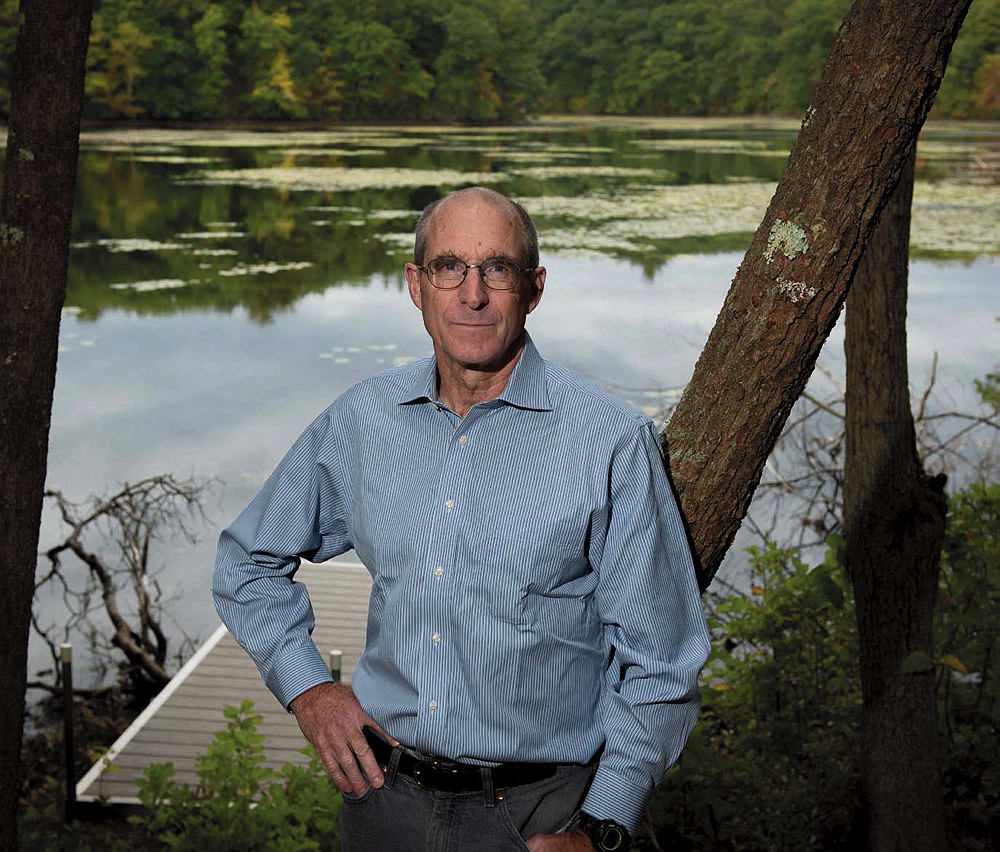
As a member of the President’s Council of Economic Advisers in 2013 and 2014, Stock worked on the Obama administration’s Clean Power Plan. He suggests, for example, that subsidizing purchases of EVs should be combined with support for offshore wind power that would ramp up renewable generating capacity. He believes such measures, combined with higher fuel-economy standards for combustion engines and a tax on carbon in the power sector, could lead to 50 percent reductions of CO2 emissions economy-wide by 2035, relative to 2005 levels.
Getting to such a 50 percent reduction would require a larger, nearly zero-carbon power grid, to provide the electricity for a vast expansion of electric vehicles. Making this scaled-up, nearly clean grid a reality would require additional “very substantial cost reductions in grid-level storage, to deal with the intermittency of sun and wind,” plus a huge push to construct a national long-distance transmission grid, because the best sites for generating renewable power are far from the major sites of demand. Stock’s analysis suggests such targets might be achievable within the existing electricity-generating industry, but only with significant support from policies such as those he outlined. In effect, the effort would require construction of a new 600-megawatt (MW) wind farm (the size of the $1.3-billion, 300-turbine Rush Creek wind farm in Colorado, the largest built in the United States to date) nearly weekly for the next 14 years. Simultaneously, annual solar-capacity additions would need to triple.
To reach more ambitious goals by 2035 would require “a nearly complete transition to EVs and a lot of progress” on making buildings “green,” Stock says. “You start with the cheapest measures and work your way up to more expensive interventions like retrofitting residences with [air- and ground-source] heat pumps.” The very last emissions cuts will be the hardest and most expensive: developing carbon-neutral methods for chemical and steel manufacturing, or for production of liquid fuels needed for aviation. “We’ll have to make some hard decisions at some point.”
From Toothless Treaties to Adaptation and Amelioration
Harvard Kennedy School (HKS) economists like Ramsey professor of political economy Richard Zeckhauser and professor of the practice of public policy Joseph Aldy believe that pushing aggressive cuts in CO2 emissions is crucial. But globally, they say, “the last clear chance has already passed for using emissions reductions alone to mitigate and avoid catastrophic climate change.” Aldy, who has been involved in international climate negotiations since the period of the 1997 Kyoto Protocol, says there is little evidence that such agreements have mitigated the upward trend of emissions, carbon concentrations, or temperatures: “They just haven’t worked” (see chart).
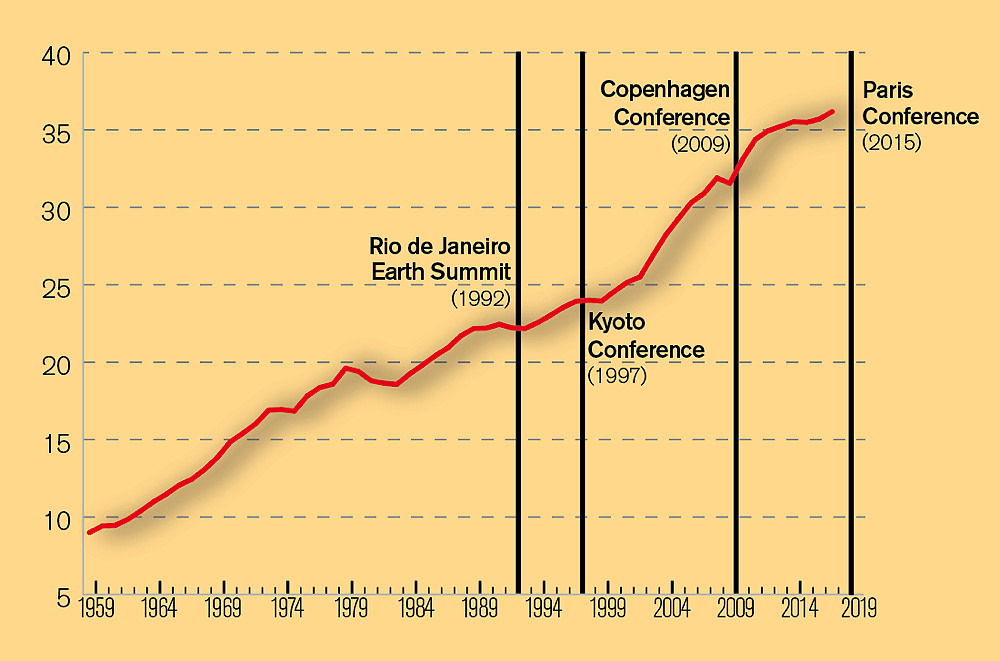
Based on his experience, Aldy says it is also “politically infeasible” to decarbonize by 2035. It’s not just the cost; inertia also perpetuates the existing energy infrastructure, he explains. In the United States, for example, permitting and siting “all the transmission lines you would need…takes a really long time.” Furthermore, the global fossil-fuel-burning capital stock—the existing burden of working cars, furnaces, power plants—contains baked in warming (not yet apparent, but predictable based on continued emissions) that is expected to carry large costs. “Even if we don’t build another coal-fired power plant anywhere in the world starting tomorrow, or another gasoline-powered automobile, and just continue to use what we have,” he says, the average global temperature increase will reach at least 1.5 degrees Celsius. The Paris Agreement, signed in 2015, aspired to limit warming to that level, and to keep long-term temperatures well below 2 degrees Celsius. (The Trump administration’s decision to withdraw from the agreement will take effect November 4.) But to limit the warming to 2 degrees—a level expected to produce extreme climate impacts—global emissions will need to be negative in the second half of the century, says Aldy. “That implies we have to electrify everything” by 2050, “and pull carbon out of the atmosphere as we’re producing energy!”
Methods for removing carbon from the atmosphere, however, are too costly at present to support large-scale use of the technology. Professor of public policy and McKay professor of applied physics David Keith founded a company that is developing a method for capturing CO2 from ambient air, for example, but new emissions continue at levels that dwarf any capacity to extract the gas. Even if emissions ceased overnight, the ocean and other carbon sinks that have absorbed vast quantities of anthropogenic CO2 will begin slowly releasing that stored gas into the atmosphere to reach equilibrium, if and when atmospheric concentrations of the gas begin to decline. To reduce atmospheric carbon by 50 ppm in the future, for example, one might have to plan to remove an amount equivalent to 100 ppm. (The same is true of the excess heat trapped by greenhouse gases, 90 percent of which has been absorbed by the oceans. That stored solar energy will slow efforts to cool Earth in the future.)
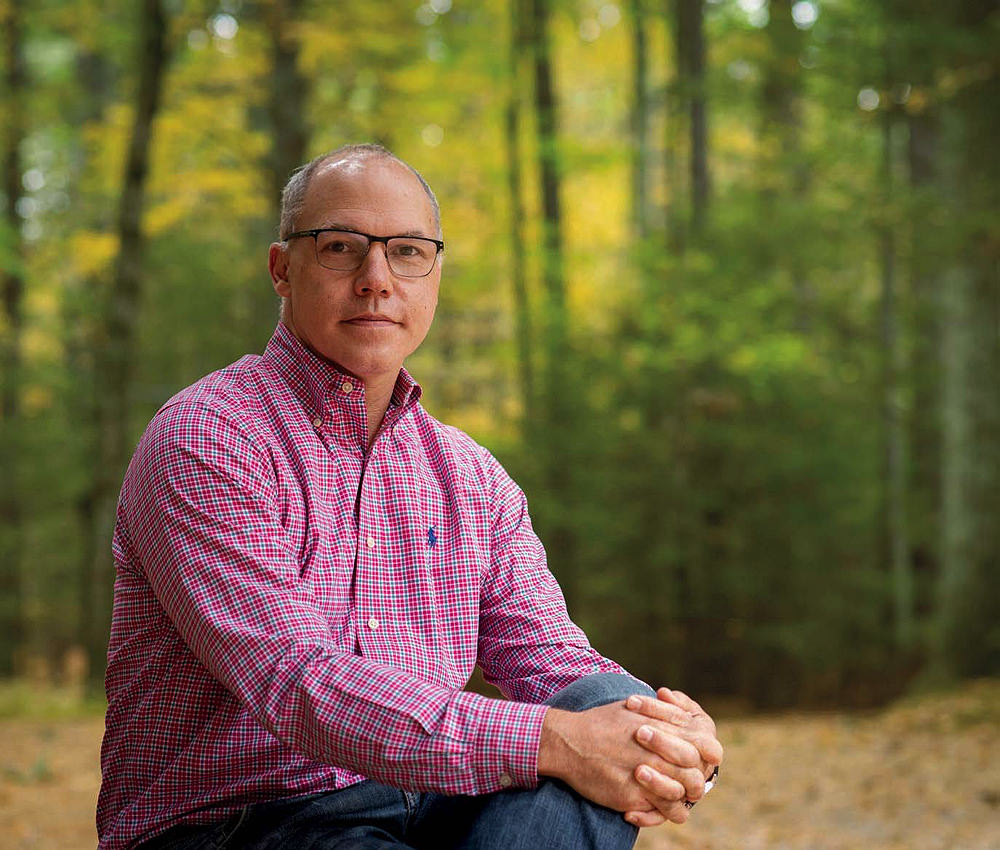
Given these realities, Aldy and Zeckhauser argue that the world needs to work aggressively on the widely accepted “three prongs” for coping with climate change: emissions mitigation via decarbonization of the energy system; adaptation; and amelioration, primarily via solar geoengineering. In all three areas, says Aldy, it is critical to recognize the role of time. “We can’t flip a switch to launch a solar radiation intervention today,” or even build sea walls in New York Harbor, without research, analysis, and construction, he points out. “These projects take decades. I fear that the slow pace of planning is going to plague our approach on both adaptation and on geoengineering.”
Adapting to a Changed Climate
Adaptation to climate change as a strategy was seen for years, particularly among environmentalists, as a threat to efforts to cut CO2 emissions. Plans to abandon areas inhospitable to agrarian life, or to retreat from advancing seas, also suggested capitulation. Even in 1990s scientific literature, adaptation was practically “a dirty word” because of concern it would undermine efforts to decarbonize, says Katharine Mach ’04, an associate professor at the University of Miami Rosenstiel School of Marine and Atmospheric Science who studies climate risk and response options. This kind of false trade-off is not helpful, she adds. “We are going to need both mitigation and adaptation, given the enormity of the changes already in the pipeline.”
Adaptation takes many forms. In parts of Africa, teaching climate refugees new skills could become an important strategy (see sidebar, “A Climate Refugee Crisis in the Offing,” page 46). The practical stakes are high in situations like these, says Aldy, because an imperfect policy response to a climate-refugee crisis, “where we haven’t prepared, and people end up stuck within the borders of a nation that literally cannot feed them,” will lead to damages far above what any economic model would predict.
First-world plans to adapt, on the other hand, will include large-scale engineering projects such as hardening subways against seawater, and expanded use of air conditioning, at least initially. The examples underscore the existence of global inequities that will enable nations and individuals with the greatest resources to adjust more readily across every dimension, from security in housing, health care, and food supply, to stability of political and economic systems.
That First World/Third World gap also seems apparent in the longstanding bias against adaptive strategies that is still reflected in international agreements, in which 90 percent of spending is focused on emissions, and only 10 percent on adaptation. Nor is adaptation a major focus of current research at Harvard.
In some ways, this is understandable, because adaptation generally doesn’t scale as well as emissions-mitigation strategies do. At the Graduate School of Design, for example, research on “green” or “net-zero” carbon-emission buildings might have global applications; work on engineering interventions to mitigate the impact of sea-level rise will be driven largely by local topography and coastal-inundation models. Still, says Aldy, the uncertainties of future climate change make investment in adaptive strategies economically attractive: they build resilience that could lessen the most adverse outcomes, while also publicizing the cost of potential damage.
Research on the cost of these policy prongs as part of a plan to limit global average temperature increase to 2 degrees Celsius by 2050 suggests that adaptation will require about $300 billion in global public finance spending annually by 2030. Emissions mitigation costs will run an additional $2 trillion per year a decade from now. And both these strategies will likely have increasing marginal costs, says Aldy: cutting the very last emissions, for example, will be the most expensive part of the project.
But whether the global political will exists to keep temperatures to that 2-degree Celsius increase—double the 1 degree Celsius of warming the world is experiencing now—remains in doubt. Current spending on both these strategies, Aldy notes, is an order of magnitude less than what is required. Those factors make amelioration, the third of the three policy paths described by Aldy and Zeckhauser, ever more likely to be taken seriously by national governments. Separate HKS research suggests that solar geoengineering, now the leading form of amelioration, could stabilize the average global temperature increase at 2 degrees Celsius for an estimated $5 billion annually—an expense Aldy and Zeckhauser project will rise only in linear fashion with the amount of cooling desired.
Amelioration: Taking an “Awful Action”
Solar geoengineering is the idea, extensively explored by David Keith and a few other scientists, of blocking 1 to 2 percent of the sunlight that reaches Earth (see “Buffering the Sun,” July-August 2013, page 36). This climate-change reduction strategy, also known as solar radiation modification (SRM), would do nothing to address the buildup of greenhouse gases in the atmosphere but could lower Earth’s temperature temporarily by increasing its albedo (reflectivity), buying humanity time to decarbonize and adapt. One version, solar aerosol geoengineering, would involve launching reflective aerosolized particles into the stratosphere from airplanes. The effect would mimic what happened when Mount Pinatubo erupted in 1991, ejecting 20 million tons of sulfur dioxide into the atmosphere. That cooled the Earth by half a degree Celsius from 1991 to 1993.
Aldy and Zeckhauser describe solar geoengineering as “an awful action” that might nevertheless be needed to help moderate global temperature during a long period of slow decarbonization and could also galvanize greater public support for cutting emissions. Because it is already technically achievable at low cost, and offers the prospect of rapid results, researchers at Harvard and elsewhere have speculated that it could be deployed by a very small number of nations without a consultative global process—by the G-7 nations, for example, or by the United States alongside China or India. At the moment, Aldy points out, nothing in U.S. or international law would prevent such a deployment. (He is skeptical that the United Nations would be the right decision-making authority, having seen representative and inclusive international agreements “blown up” at the last minute by that organization’s complicated decision-making rules.)
“Potentially interesting,” he adds, “is the fact that the countries most likely to benefit are lower-income. They don’t have the resources for adaptation, and will weigh the low costs of geoengineering interventions against the high costs of building sea walls and moving populations.” Work by students of Keith, the faculty director of Harvard’s Solar Geoengineering Research Program, indicates that this type of intervention would decrease global inequality substantially because the benefits are biggest for the poorest populations. “For me,” he says, “that’s the fundamental argument for anything in public policy.”
The aim of solar geoengineering would be to keep Earth’s temperature as close to equilibrium as possible says Peter Huybers, a professor of earth and planetary sciences and of environmental science and engineering. “That’s what we know best.” And from an engineering perspective, he suspects such action could do more good than harm—“at least if you’re smart about it, start out very small, and proceed in a reversible way.”
Keith’s modeling also suggests that if the process were used to halve warming, that would moderate climate hazards nearly everywhere. Only 1.3 percent of land areas would see a change in water availability—as increased moisture, not as drought. In addition to attenuating global average temperature, this halving of warming would in theory lessen the intensity of tropical cyclones, reduce regional changes in water availability, ease extreme precipitation and extreme temperatures, and even reduce atmospheric carbon concentrations and ocean acidification.
Ironically, the biggest challenge may be the same one facing decarbonization: global governance. “You have to organize and collectively agree about the actions that are necessary,” Huybers points out. “That’s why it’s essential that we develop international governance criteria around both research and any potential deployment.”
Keith has long highlighted that even if his promising scenarios prove wholly accurate, any intervention in the climate system could create winners and losers. Changes in weather patterns, for example, could benefit agriculture in one country more than another. He and colleagues have suggested that one way to handle such unpredictable effects would be to establish an insurance system that would pay out to “losers” whenever climate indices deviated from set ranges. Such a system would require at least some kind of global oversight mechanism, and might even trigger the establishment of a form of global governance.
Keith has led thinking about how to improve solar geoengineering’s effectiveness and reduce its risks for more than two decades. Beyond inequitable outcomes, he says, are other concerns: the health impacts of ground-level particulate pollution, the possibility of “climate wars” over who controls the global thermostat, and the risk of “termination shock”—the possibility that an intervention is suddenly suspended for unanticipated reasons, causing temperatures to spike as CO2-related greenhouse warming rapidly reestablishes itself.
Another risk is political. Economist James Stock admits the technology is extremely cost-effective. “When you run the models,” including it as part of a comprehensive global decarbonization plan to keep peak temperatures below a set threshold, “this is a really cheap way to avoid some important damages.” But he opposes it as “yet another excuse not to deal with climate.” World governments, for example, might agree to cap CO2 at 500 ppm, but miss that target because eliminating the last industrial and aviation uses of fossil fuels is so difficult and expensive. As the cumulative CO2 levels rise higher, more and more particles would need to be injected into the atmosphere to keep the temperature below damaging levels. “And then,” says Stock, “you are seriously addicted.”
That idea is not far-fetched, he argues. The Trump administration, in its first round of fuel-economy standards, projected that CO2 would reach 800 ppm in 2100—and then used that as an argument to lower fuel consumption standards, because burning a little more gasoline would make no difference. Stock calls this “the solar geoengineering catastrophe—that we’re going to be a desert anyway, so let’s just use a little more petroleum.”
Raymond Pierrehumbert ’76, Halley professor of physics at Oxford, worries that the general public won’t understand that solar geoengineering cannot solve the climate-change problem. Instead, the technology may appear to be “a cheap and safe way out,” something to be deployed in an emergency when “we’re in a panic and people are dying from heat waves.” That scenario, he points out, is not one in which solar geoengineering would be useful (nor is it the one that Keith models). Pierrehumbert stresses instead that the technology might attenuate peak temperatures as one part of a project to first, end emissions, and second, to lower the atmospheric concentration of CO2 by actively removing the accumulated carbon. The ability to pull carbon out of the atmosphere, Pierrehumbert believes, is therefore “essentially a prerequisite….If you have robust air capture of CO2, that is the one thing that gives you an exit strategy that doesn’t involve termination shock.” (Keith notes that tapering SRM slowly would also avoid “termination shock.”)
A two-degree world is one that commits to long-term sea-level rise of 39 feet, around the height of a four-story building.
Pierrehumbert says that the way environmentalists and some IPCC models often frame the climate issue exacerbates the risk that solar geoengineering will be misused. Describing climate change as “a problem that must be solved in 10 years…implies that there is a cliff, that we either make progress or all is lost.” There are a few true potential tipping points—the collapse of the West Antarctic ice shelf is one—but emphasizing these “feeds into this false sense of imminent catastrophe and emergency.” A two-degree world, he acknowledges, “is a world with catastrophes—I wouldn’t even call them manageable”—but “it’s not the scenario where half the world becomes uninhabitable to mammals because of heat waves. It’s not, in that sense, an existential risk.”
Keith counters that the idea that scholars should withhold knowledge from the public because of possible misunderstanding or misuse is anti-democratic: “If the facts suggest, even with some uncertainty, that this could save a lot of lives and protect people from harm, it’s our job as scientists to say that, even if we are worried that it is going to be misused.” He expects, in fact, that people whose fortunes are bound up with oil and gas will try to exploit the prospect of solar geoengineering, using it to argue against emissions cuts. “We should all think about how to weaken that impulse,” he says. “But while I think that this is a concern”—he first raised this issue of moral hazard 20 years ago—“I don’t see an ethically sound argument against doing the research.”
The Research Imperatives
“I’m incredibly skeptical of the idea that you could introduce a few million tons of particles into the stratosphere without negative consequences,” says Frank Keutsch. That’s an extraordinary thing for the Stonington professor of engineering and atmospheric science to say, given that he is the principal investigator in what could become the first field experiment connected to stratospheric solar geoengineering, the Stratospheric Controlled Perturbation Experiment (SCoPEx). “It just seems hard to imagine, right? So why would we do this?”
Keutsch says he is motivated by the increased warming already built into the climate system. “When I started thinking about this, it was a big, personal battle. Do I really want to conduct this research? I fully appreciate the moral hazard that it represents.” But he worries that the extreme conditions already fixed in Earth’s climate future—and the ensuing migrations that might provoke international conflict—could soon force decisionmakers to consider the technology, because it is the only available action with discernible consequences in time frames people and politicians generally understand. “And so, I think it behooves scientists…to try and provide facts that decisionmakers can use.”
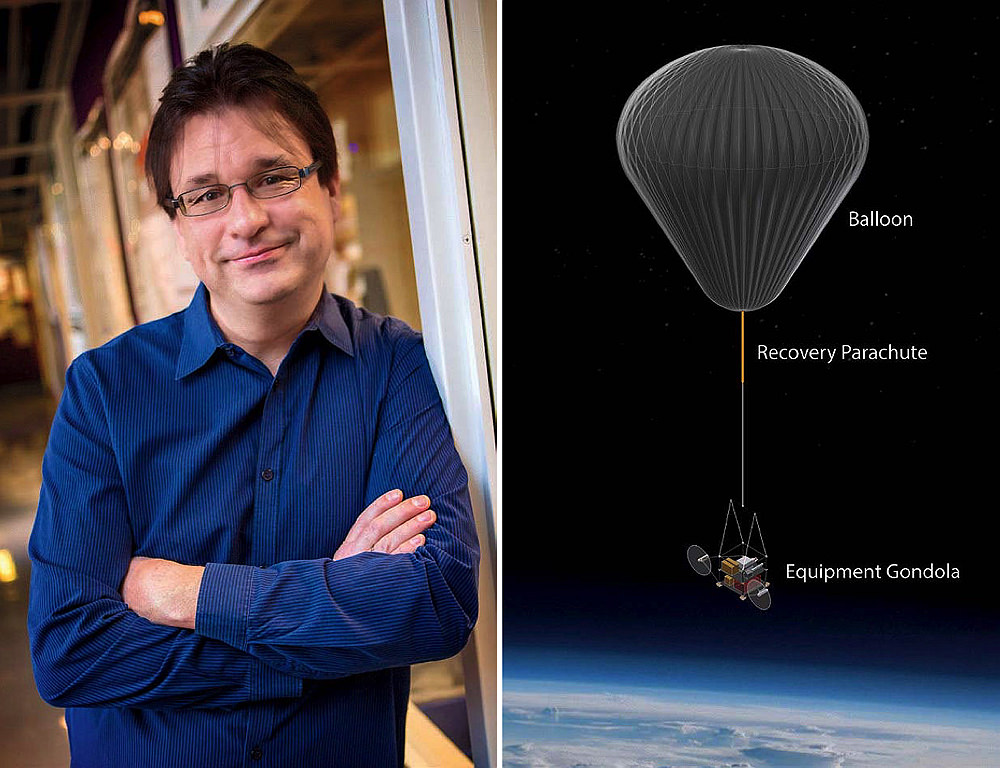
What would the cooling be like, he wonders. Would it cool the planet evenly, affect rainfall, plant growth, weather, the ways the climate system works now? What happens when the particles fall back to earth? Do they affect cloud formation, human health, terrestrial ecosystems? The “huge number of questions” will take decades to answer. “Given where climate is headed,” he says, “I’m really worried that we are running out of time. And as a scientist, I really have a moral obligation to try to discover what can be known.”
He is also committed to communicating the intrinsic nature of climate engineering accurately to the public. He uses the analogy of a painkiller. Solar geoengineering “only treats a symptom.” Like an opioid, it doesn’t address the cause of the problem, and there are risks of side effects—and addiction.
The research Keutsch proposes (Keith is also part of the team) is designed to test whether the use of calcium carbonate to cool the planet by scattering sunlight back into space might avoid the pitfalls associated with sulfur dioxide. Sulfur particles injected into the atmosphere by a volcanic eruption can accelerate stratospheric ozone destruction if man-made chlorofluorocarbon pollutants are present. Keutsch, who’s also a professor of chemistry and chemical biology, has already begun experimenting with calcium carbonate, simulating the stratosphere by lowering the temperature and pressure within a meter-long “flue tube.” Then he performs experiments that can inform global models of stratospheric ozone loss. So far, his lab group and Keith’s have measured about half of the most important reactions that might affect ozone. “Let’s say we measure the other half and find that calcium carbonate is a great material,” he says. “Can we really believe that a one-meter tube will capture the entire complexity of the stratosphere?”
That’s the reason for the SCoPEx project, an aerosol-microphysics experiment to be conducted from a battery-propelled balloon platform roughly 12 miles above the Earth. Moving slowly, the balloon would release a thin plume of calcium carbonate about half a mile long, using the propellers to mix the aerosol as well as move the balloon along. Once the full plume has been released, the balloon will turn and fly back through it, sampling atmospheric reactions and recording aerosol dynamics. Keutsch doesn’t know what he might find. Calcium carbonate might actually help preserve stratospheric ozone, he says. The “perfect aerosol” would be one that doesn’t affect stratospheric chemistry or temperature at all: “The only thing it would do is scatter maximum sunlight and hence cool down the planet.”
An independent advisory committee is reviewing SCoPEx to ensure that sources of funding are untainted by fossil-fuel interests, to conduct legal and scientific reviews, and to devise a plan for robust public education and engagement. Keutsch says the experiment will not proceed until all the committee’s recommendations have been addressed. Given that the balloon will release less aerosol than a single commercial airline flight, such unusual oversight might seem excessive. But “knowledge is not neutral,” notes Katharine Mach, the University of Miami expert on climate risk and response options who serves on the committee.
The experiment involves just a “little puff of dust” but in “profound ways it gets right to the heart of the climate challenge…”
“Does humanity need to do solar radiation management?” is not solely a scientific question because any large-scale intervention will affect all life on Earth, she points out, and therefore “no scientist should be able to give a definitive answer on that.” The experiment itself involves putting just “a little puff of dust into the atmosphere,” she says, but “in some unbelievably profound ways it gets right to the heart of the climate challenge and our failure to make progress to date. Everyone on the committee is very upfront about our recognition that geoengineering is not the solution to the climate issue and that the scale of risk requires global and national-level governance.” With respect to SCoPEx itself, Mach continues, it is appropriate that there is “a governance process to decide whether this experiment should occur, attuned to the benefits and risks of research.”
• • •
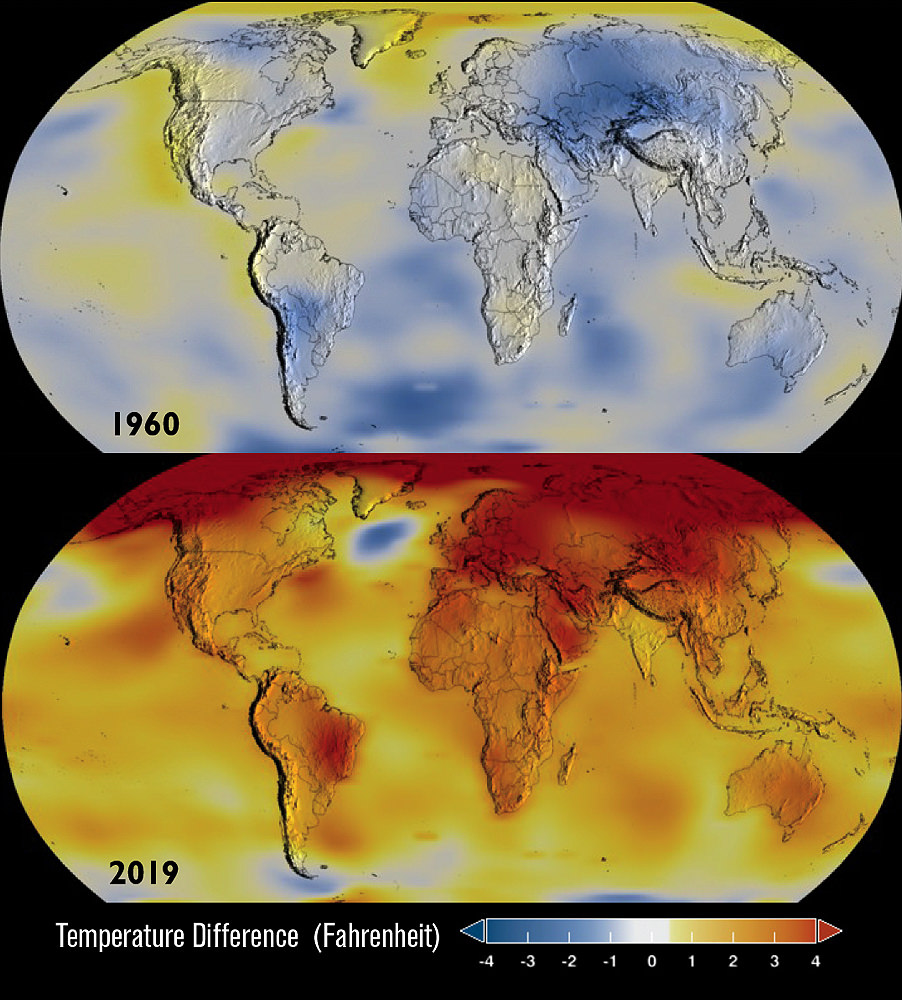
1960 versus 2019: average surface temperatures have risen fastest over land at high latitudes. | Heat maps courtesy of NASA Scientific Visualization Studio
Dan Schrag, who is teaching the first University-wide course on climate change this fall, says it shouldn’t be “only national labs or the military” that study solar aerosol geoengineering. “We should have the best climate scientists in the world thinking about it—including all the ways that it could go wrong.” It might stabilize the Greenland ice sheet, he points out, but fail to avert a potential collapse of the West Antarctic ice sheet, whose stability depends on the temperature of ocean currents that can melt ice shelves and submarine portions of glaciers from below.
Schrag says his view of geoengineering is a little like Churchill’s assessment of democracy: that it is “‘the worst form of Government except for all those other forms….’ Taking control of the planet’s thermostat is a terrifying idea. I just think that a lot of people don’t understand that climate change is even more terrifying.”










